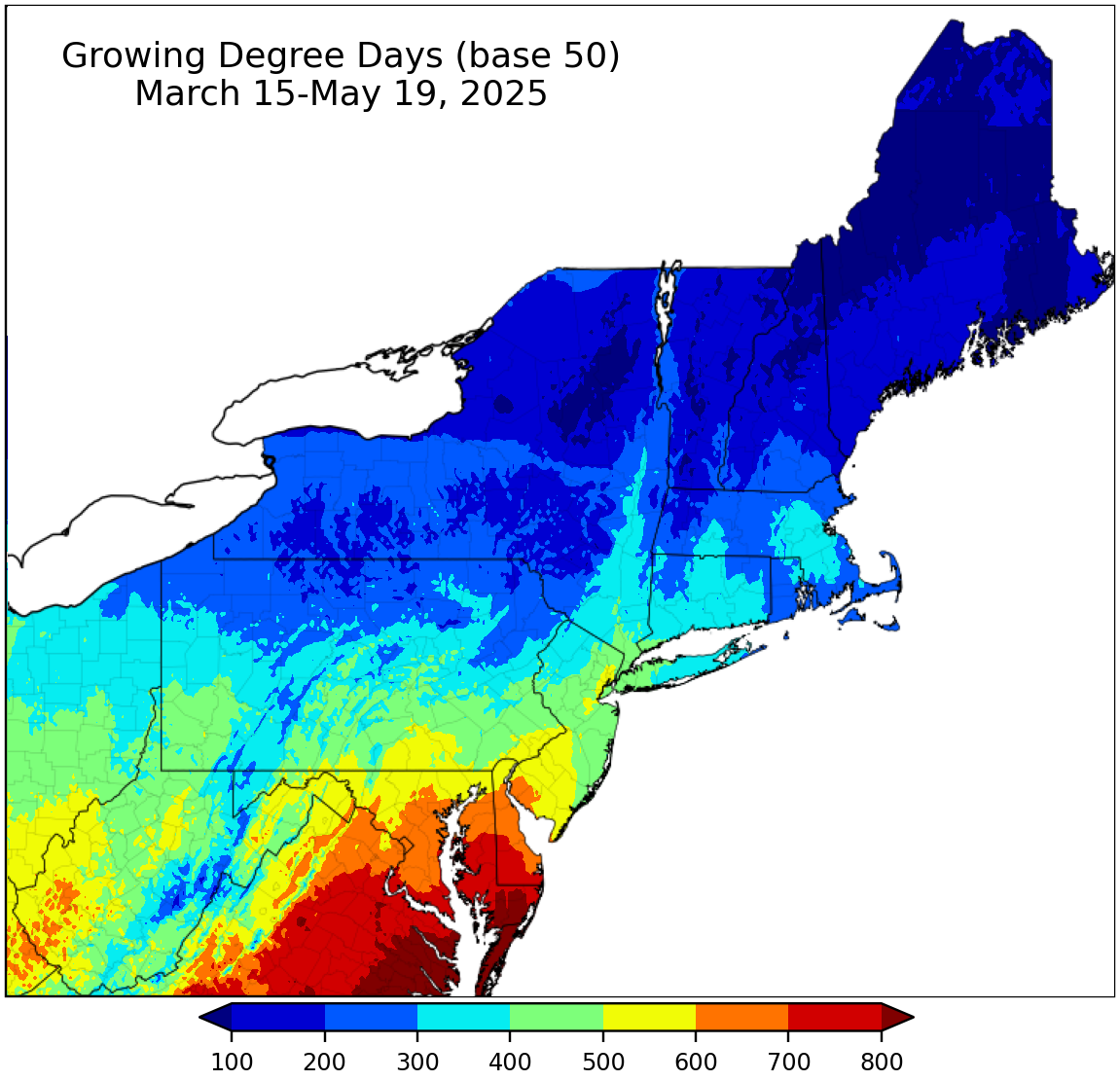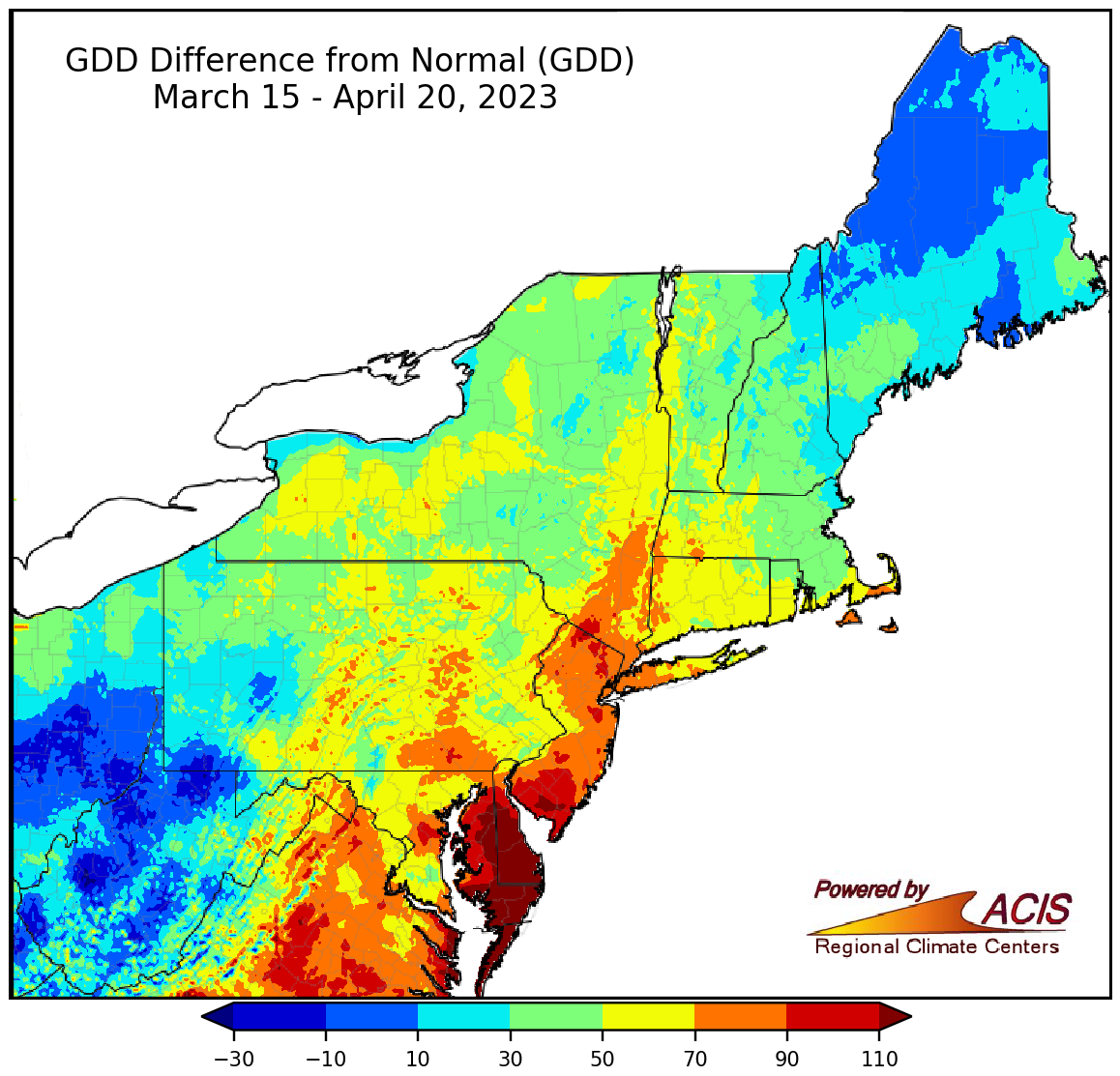© Cornell University, 2016. Credits: Tool Developed by Art DeGaetano, Rick Moore, Brian Belcher & Ben Eck.
Please take a few minutes to fill out a brief questionnaire on the CSF tools, so that we can continue to improve them, and develop new tools that are most needed! The questionnaire is voluntary and confidential, but we appreciate your input!
How do I use this tool?
View a video introduction of the latest version, with practical usage examples:
View our video tool tutorial on YouTube below:
Instructions on using this tool
Choosing Your Location
- Click the “Edit” button, which pops up a dialog box with text field and a map (click the small circle button at the top right to exit if needed)
- Create a new location by 1) entering your address, zip code, county, in the text field and clicking the “GO” button, OR 2) clicking on the map at any location in the Northeast
- The “Confirm Location Information” dialog box will appear after clicking “GO,” along with a yellow marker at the new location.
- Click “Save and Select” when you want to see the graph for your chosen location
- Click “Save” when the yellow marker is in the correct location, but you want to add more locations (the color of the new symbol will be changed to blue)
- Click “Cancel” when you do not want to keep the location
Selecting or Deleting Additional Locations
- You may select or delete a location from those already shown (upon clicking “Edit”) by hovering and then clicking on an existing symbol once the white box with existing location details has appeared
- The “Confirm Location Information” dialog will appear at the top of the map
- Click “Select” when you want to see the graph for that location. When the dialog box closes, the color of the selected location’s marker will be changed to red, and the color of the previously selected marker will be changed to blue. The dialog box will close and your graph will appear
- Click “Delete” to delete the location, immediately removing the marker from the map
- Click “Cancel” when you want to do nothing
Viewing a Summary of Locations
- Clicking on the “Summary” button displays a summary table of all locations that you have saved. For each location will will see the address, planting date, GDD base, season-to-date GDD accumulation, and the forecasted target date (if enabled).
- When Targets are enabled, this table will also be color-coded based on how close (in time) the specified target is to the current GDD accumulation total.
Selecting Your Planting Date
- To select a date, click on the small green calendar to display a larger, interactive calendar from which to choose a date by clicking on it, which will automatically update the graph (switch between months by clicking the small arrow in the top left and right of the calendar pop-up box)
Selecting for Growing Degree Day Threshold
- There are multiple options for Growing Degree Day base selection from the dropdown menu. For Base 50, there is an additional option for limiting maximum and minimum daily temperatures (86/50) during calculation.
- The graph will automatically update depending on your choice for every parameter.
Enabling and Selecting Growing Degree Day Targets
- Toggle on/off “enable Targets” to activate/deactivate this feature. When activated, a slider will appear where you can change the target value of interest.
- Chosen GDD target thresholds are displayed on the graph, and used in the location summary table.
Choosing Your Season view
- Below the growing degree days there is a group of buttons that allow you to view “Season to Date” or “Season Outlook” charts by clicking on the appropriate button. The “Season to Date” chart contains data for everyday from the beginning of the season until the last forecast date. The “Season Outlook” chart shows the forecast extended to the end of the growing season based on historical accumulations for the remainder of the growing season.
- Each chart shows reference lines to put the current year’s accumulations in context. The most recent 15-year average, the 30-year (1981-2010) average, historical maximum and historical minimum are charted with the selected year’s accumulations. First (Fall) and Last (Spring) Freeze dates for the past 15 years are also provided for reference on these charts.
Additional information
- The “Info” button provides additional information regarding any methods, models and data used within this tool. References and publications are provided here.
Why is this tool needed?
The Growing Degree Day (GDD) calculator measures heat accumulation to help agricultural producers predict when a crop will reach important developmental stages. It can also be used to help predict potential pest and disease threats.
How does this tool work?
This tool plots Growing Degree Days (GDD), also called Growing Degree Units (GDUs), which measure heat accumulation in order to predict plant and insect development. In a stress-free environment, the development rate of a plant is dependent on temperature. Using the expected temperature of the summer season, based on previous years, this tool can help predict the best days to plant, harvest, and fertilize.
GDDs are calculated by taking the average of the daily maximum temperature and minimum temperature, and then subtracting a base temperature. The base temperature is the lowest temperature at which a crop will grow. As an example, a common base for many crops is 50°F. On days when the average temperature is below 50°F, the GDD value is set to zero. Some crops also have a maximum temperature above which growth slows. This temperature is usually approximately 86°F. Thus, the 86/50 degree day method is often used to assess crop development. In this method 86°F refers to the maximum temperature and 50°F the minimum. In computing these degree days, maximum temperatures above 86°F are set to 86 and minimum temperatures below 50°F are set to 50. Typically the 86/50 method is used to assess crop development, particularly corn, while the use of only the 50° base temperature is used to track pest appearance.
Producers can use this tool to:
- Make the best selection of crop varieties, optimize planting and harvesting times, etc…
- Respond to sudden changes: to alter planting plans, seed varieties, etc. if unpredictable weather (i.e. heavy rainfall) occurs
- Assess how a particular season compares to historical or future seasons given climate change.
How is our GDD Calculator different from others?
This calculator uses a moving 15-year average of the most recent 15 years to make predictions, and is updated each year to include the most recent data. Other GDD tools use a fixed 30-year average to make calculations, as opposed to the moving 15-year average, which allows the tool to make predictions that might better align with the changing climate and bring you more up to date information to improve your crop yields.
Please note that this tool only covers the Northeastern United States. If you live outside this region, check out other regional GDD tools:
- Southeast: AgroClimate.org
- Midwest: Useful to Usable
- General: The Weather Channel
Usage Example: 2019 Corn Production
Weather during the 2019 growing season is creating numerous challenges for corn producers. Cool, wet conditions during the traditional planting time forced many to plant later than usual, setting up a series of decisions that producers must face as the season progresses.
Dr. Kitty O’Neil, Field Crops and Soil Specialist with the North Country Regional Ag Team, outlined some of these early-season decisions that farmers are faced with during her introduction to CSF’s Growing Degree Day Calculator. During this video, practical examples of GDD usage are presented. These examples include how to quickly assess from the tool if a late-planted variety may interact with the first freeze in the Fall, forcing important decisions at planting time during Spring 2019.
Joe Lawrence, Dairy Forage Systems Specialist with PRO-DAIRY, has also outlined using this tool for silking to silage harvest. An old rule of thumb for duration of this growth stage has been 6-7 weeks, but Joe points out that this should not be relied on, especially during the 2019 growing season. Progression from silking to silage harvest will occur later in the 2019 growing season, and this means an increased likelihood that this stage will take longer to complete. By setting the silking/tasseling date as your start date, together with a target of 750-800 GDDs (86/50 method, based on work by Bill Cox at Aurora Research Farm), a projected date for silage harvest is obtained from the tool. You can catch Joe at Empire Farm Days when he presents “Corn Silage Harvest Strategy: One chance to get it right”.
Unsure of what steps to take next? Click here to find your local Extension office for more detailed advice.




